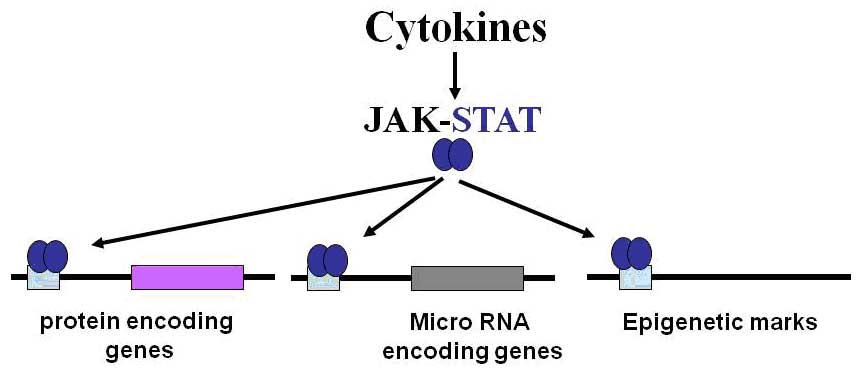
Lothar Hennighausen
301-496-2716
lotharh@mail.nih.gov
Research Overview
The Laboratory of Genetics and Physiology (LGP) explores the genetic circuitry that integrates the JAK-STAT signaling pathway. The emphasis is on theoretical and medical problems related to the role of cytokines with a focus on the transcription factor STAT5. Using traditional and cell-specific gene knock-out mice, researchers in LGP have discovered that STAT5 is essential for the development and function of several distinct cell types.
Current research is aimed towards an understanding of the genetic logic that controls cell specific functions of STAT5 in mammary and hematopoietic stem cells and mammary epithelial lineages and in muscle physiology.

LGP scientists have discovered that cytokine-STAT5 signaling is essential for the establishment of mammary alveolar progenitor cells (Yamaji et al., 2009). Using large scale genomic and deep sequencing approaches LGP scientists explore the chromatin landscape of mammary stem and progenitor cells (Yamaji, Robinson, Zhu, Riedlinger) as a means to gain insight into mechanisms that control lineage decisionmaking. ChIP-seq approaches have uncovered that STAT5 is likely to control the development of the mammary alveolar lineage not only through the regulation of protein-encoding genes but also through the activation of microRNA genes (Feuermann, Yamaji) and engraving epigenetic tags into the genome. Mouse genetics and primary cell culture systems are being employed to uncover the role of these microRNAs and the epigenetic marks in mammary and hematopoietic lineages.

Selected References
Yamaji, D., Robinson, W.G., Na, R., Feuermann, Y., Pechold, S., Chen, W. and Hennighausen, L. (2009) Development of mammary luminal progenitor cells is controlled by the transcription factor STAT5A. Genes and Development, 23, 2382-2387.
Kimura, A, Rieger, M.A., Simone, J.M., Cheng, W., Wickre, M., Zhu, B.-M., Hoppe, P.S., O’Shea, J.J, Schroeder, T and Hennighausen, L. (2009) The transcription factors STAT5A/B regulate GM-CSF-mediated granulopoiesis. BLOOD, 114, 4721-4728.
Klover, P., Chen, W., Zhu, B.M. and Hennighausen, L. (2009) Skeletal muscle growth and fiber composition in mice are regulated through the transcription factors STAT5a/b: linking growth hormone to the androgen receptor. FASEB J., 23, 2140-2148.
Hosui, A., Kimura, A., Yamaji, D., Zhu, B.M., Na, R. and Hennighausen, L. (2009) Loss of STAT5 causes liver fibrosis and cancer development through increased TGF-b and STAT3 activation. J. Exp. Med., 206, 819-831.
Hennighausen, L. and Robinson, G.W. (2008) Interpretation of cytokine signaling through the transcription factors STAT5A and STAT5B. Genes Dev. 22, 711-721 (review).
Lee, J.-Y., Muenzberg, H., Gavrilova, O., Reed, J.A., Berryman, D., Villanueva, E.C., Louis, G.W., Leinninger, G.M., Bertuzzi, S., Seeley, R.J., Robinson, G.W., Myers, Jr M.G. and Hennighausen, L. (2008) Loss of cytokine-STAT5 signaling in the CNS and the pituitary gland alters energy balance and leads to obesity. PLoS ONE, 3, e1639.
Zhu, B.M., Koenig-McLaughlin, S., Na, R., Liu, J., Cui, Y., Martin, C., Kimura, A., Robinson, G.W., Andrews, N.C. and Hennighausen, L. (2008) Hematopoietic cell-specific Stat5-null mice display microcytic hypochromic anemia due to reduced transferrin receptor gene expression. Blood, 112, 2071-2080.
Cui, Y., Hosui, A., Sun, R., Shen, K., Gavrilova, O., Chen, W., Cam, M.C., Gao, B., Robinson, G.W., and Hennighausen, L. (2007) Loss of Stat5 leads to hepatosteatosis and impaired liver regeneration. Hepatology, 46, 504-513.
Klover, P. and Hennighausen, L. (2007) Postnatal body growth is dependent on the transcription factors Stat5a/b in muscle: a role for autocrine / paracrine IGF-1. Endocrinology, 148, 1489-1497. This article was accompanied by an editorial.
Hennighausen, L. and Robinson, G.W. (2005) Information networks in the mammary gland. Nature Rev Mol Cell Biol., 6, 715-725 (review).
Cui, Y., Riedlinger, G., Miyoshi, K., Tang, W., Li, C., Deng, C.X., Robinson, G.W. and Hennighausen, L. (2004) Inactivation of Stat5 in mouse mammary epithelium during pregnancy reveals distinct functions in cell proliferation, survival and differentiation. Mol. Cell. Biol., 24, 8037-8047.
Miyoshi, K., Shillingford, J.M., Smith, G.H., Grimm, S.L., Wagner, K.U., Oka, T., Rosen, J.M., Robinson, G.W. and Hennighausen, L. (2001) Signal transducer and activator of transcription 5 (Stat5) controls the specification and proliferation of mammary alveolar epithelium, J. Cell Biol., 155, 531-542.
Liu, X., Robinson, G.W., Wagner, K.-U., Garrett, L., Wynshaw-Boris, A. and Hennighausen, L. (1997) Stat5a is mandatory for adult mammary gland development and lactogenesis. Genes and Dev. 11, 179-186.
Complete list of publications